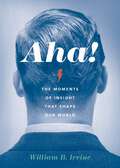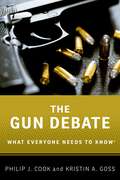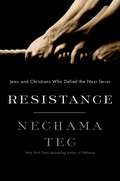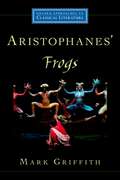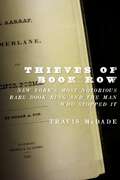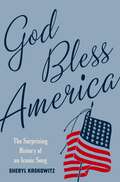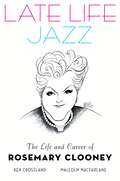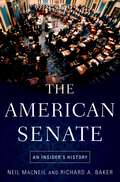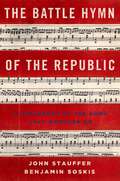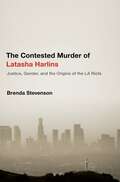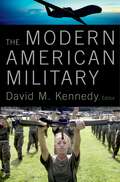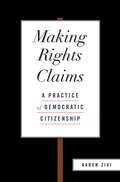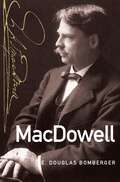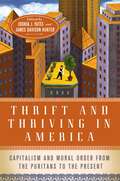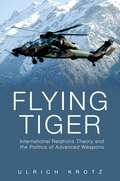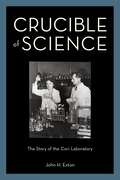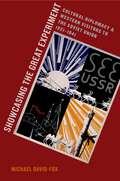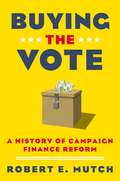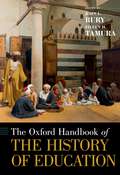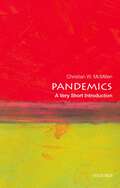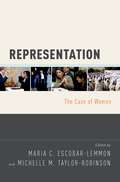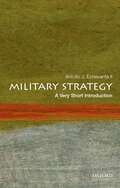- Table View
- List View
Aha!: The Moments of Insight that Shape Our World
by William B. IrvineGreat ideas often develop gradually after studying a problem at length--but not always. Sometimes, an insight hits like a bolt from the blue. For Archimedes, clarity struck while he was taking a bath. For Gustav Mahler, it came as the blades of his oars touched the water. And for Albert Einstein, it emerged while he was talking to a friend. Why do these moments of insight strike so suddenly? Why do they so often come to us when we are focused on something completely unrelated? And when great ideas "come to" us, where do they come from? In Aha!: The Moments of Insight that Shape Our World, philosopher William B. Irvine, author of A Guide to the Good Life and On Desire, explores these epiphanies, from the minor insights that strike us all daily, to the major realizations that alter the course of history. Focusing on aha moments as they take place in five different domains--religion, morality, science, math, and art--Irvine provides case studies that shed light on the different ways epiphanies happen in the different domains, and on their differing social impact. Along the way, he describes some of the great aha moments in history, from ancient times to the present day. We like to think that our greatest thoughts are the product of our conscious mind. Irvine demonstrates, though, that it is our unconscious mind that is the source of our most significant insights, and that the role the conscious mind plays in eliciting these insights is to try, unsuccessfully, to solve certain problems. Only if the conscious mind is willing to do this--and thereby experience considerable frustration--is the unconscious mind likely to reward it with a breakthrough insight-that the conscious mind will then take credit for. Irvine explores not only the neuroscience of aha moments but also their personal and social ramifications. How does a person respond to having a breakthrough insight that goes against a dominant paradigm? And how does the world respond when she shares that insight? Irvine shows that in many cases, what is most remarkable about those who have had the great insights of human history is not their but their courage and perseverance in fighting for the world to accept those insights. Aha! is a must-read for cognitive scientists, intellectual historians, philosophers, and anyone who has ever been blown away by the ideas that enlighten us when we least expect it.
The Gun Debate: What Everyone Needs to Know® (What Everyone Needs To Know®)
by Philip J. Cook Kristin A. GossNo topic is more polarizing than guns and gun control. From a gun culture that took root early in American history to the mass shootings that repeatedly bring the public discussion of gun control to a fever pitch, the topic has preoccupied citizens, public officials, and special interest groups for decades. The Gun Debate: What Everyone Needs to Know® delves into the issues that Americans debate when they talk about guns. With a balanced and broad-ranging approach, noted economist Philip J. Cook and political scientist Kristin A. Goss thoroughly cover the latest research, data, and developments on gun ownership, gun violence, the firearms industry, and the regulation of firearms. The authors also tackle sensitive issues such as the effectiveness of gun control, the connection between mental illness and violent crime, the question of whether more guns make us safer, and ways that video games and the media might contribute to gun violence. No discussion of guns in the U.S. would be complete without consideration of the history, culture, and politics that drive the passion behind the debate. Cook and Goss deftly explore the origins of the American gun culture and the makeup of both the gun rights and gun control movements. Written in question-and-answer format, the book will help readers make sense of the ideologically driven statistics and slogans that characterize our national conversation on firearms. This book is a must-read for anyone interested in getting a clear view of the issues surrounding guns and gun policy in America. What Everyone Needs to Know® is a registered trademark of Oxford University Press.
The Gun Debate: What Everyone Needs to Know® (What Everyone Needs To Know®)
by Philip J. Cook Kristin A. GossNo topic is more polarizing than guns and gun control. From a gun culture that took root early in American history to the mass shootings that repeatedly bring the public discussion of gun control to a fever pitch, the topic has preoccupied citizens, public officials, and special interest groups for decades. The Gun Debate: What Everyone Needs to Know® delves into the issues that Americans debate when they talk about guns. With a balanced and broad-ranging approach, noted economist Philip J. Cook and political scientist Kristin A. Goss thoroughly cover the latest research, data, and developments on gun ownership, gun violence, the firearms industry, and the regulation of firearms. The authors also tackle sensitive issues such as the effectiveness of gun control, the connection between mental illness and violent crime, the question of whether more guns make us safer, and ways that video games and the media might contribute to gun violence. No discussion of guns in the U.S. would be complete without consideration of the history, culture, and politics that drive the passion behind the debate. Cook and Goss deftly explore the origins of the American gun culture and the makeup of both the gun rights and gun control movements. Written in question-and-answer format, the book will help readers make sense of the ideologically driven statistics and slogans that characterize our national conversation on firearms. This book is a must-read for anyone interested in getting a clear view of the issues surrounding guns and gun policy in America. What Everyone Needs to Know® is a registered trademark of Oxford University Press.
Resistance: Jews and Christians Who Defied the Nazi Terror
by Nechama TecNechama Tec's Defiance, an account of a Jewish partisan unit that fought the Nazis in the Polish forests during World War II, was turned into a major feature film. Yet despite the attention this film brought to the topic of Jewish resistance, Tec, who speaks widely about the Holocaust and the experience of Jews in wartime Poland, still ran into the same question again and again: Why didn't Jews fight back? To Tec, this question suggested that Jews were somehow complicit in their own extermination. Despite works by Tec and others, the stereotype of Jewish passivity in the Holocaust persists. In Resistance, Tec draws on first-hand accounts, interviews, and other sources to reveal the full range of tactics employed to resist the Nazi regime in Poland. She compares Jewish and non-Jewish groups, showing that they faced vastly different conditions. The Jewish resistance had its own particular aims, especially the recovery of dignity and the salvation of lives. Tec explores the conditions necessary for resistance, including favorable topography, a supply of arms, and effective leadership, and dedicates the majority of the book to the stories of those who stood up and fought back in any way that they could. Emphasizing the centrality of cooperation to the Jewish and Polish resistance movements of World War II, Tec argues that resistance is more than not submitting--that it requires taking action, and demands cooperation with others. Whereas resilience is individual in orientation, Tec writes, resistance assumes others. Within this context, Tec explores life in the ghettoes, the organizations that arose within them, and the famous uprising in Warsaw that began on January 18, 1943. She tells of those who escaped to hide and fight as partisans in the forests, and considers the crucial role played by women who acted as couriers, carrying messages and supplies between the ghetto and the outside world. Tec also discusses resistance in concentration camps, vividly recounting the Auschwitz-Birkenau camp uprising on October 7, 1944. The refusal of the rebel leaders to give information under unspeakable torture, Tec displays, was just one more of the many forms resistance took. Resistance is a rich book that forever shatters the myth of Jewish passivity in the face of annihilation.
Aristophanes' Frogs (Oxford Approaches to Classical Literature)
by Mark GriffithAristophanes is widely credited with having elevated the classical art of comedy to the level of legitimacy and recognition that only tragedy had hitherto achieved, and producing some of the most intriguing works of literature to survive from classical Greece in the process. Among them, Frogs has a unique appeal; written and performed in 405 BCE, the comedy won first prize in that year's Lenaea festival competition and was re-performed soon thereafter--a rare occurrence for comedies at the time. Frogs has been admired and quoted by readers and critics ever since, a testament to its timeless appeal; it remains among the most approachable of Aristophanes' plays, as well as perhaps the richest of all in insights it provides into ancient Greek cultural attitudes and values. Mark Griffith's study of the Frogs is the first single book to offer a reliable and sophisticated account of this play in light of modern notions of culture, performance, democracy, religion, and aesthetics. After placing the work in its original historical, cultural, and biographical context, Griffith goes on to underscore the originality of Frogs in relation to parallel developments in the tragedies of Aeschylus and Euripides, among others. He highlights the play's unique portrayal of the figure of Dionysus, the Eleusinian mystery cult, and the question of life after death. This title provides not only a detailed analysis of the play and a concise account of its reception, but also a succinct introduction to ancient Greek comedy, exploring the extraordinary range of theatrical conventions, moral and aesthetic assumptions, and religious beliefs that underlie the action of Aristophanes' play. The book provides an invaluable companion to Aristophanes and the theater of classical Greece for students and general readers alike.
Thieves of Book Row: New York's Most Notorious Rare Book Ring and the Man Who Stopped It
by Travis McDadeNo one had ever tried a caper like this before. The goods were kept in a secure room under constant scrutiny, deep inside a crowded building with guards at the exits. The team picked for the job included two old hands known only as Paul and Swede, but all depended on a fresh face, a kid from Pinetown, North Carolina. In the Depression, some fellows were willing to try anything--even a heist in the rare book room of the New York Public Library. In Thieves of Book Row, Travis McDade tells the gripping tale of the worst book-theft ring in American history, and the intrepid detective who brought it down. Author of The Book Thief and a curator of rare books, McDade transforms painstaking research into a rich portrait of Manhattan's Book Row in the 1920s and '30s, where organized crime met America's cultural treasures in dark and crowded shops along gritty Fourth Avenue. Dealers such as Harry Gold, a tough native of the Lower East Side, became experts in recognizing the value of books and recruiting a pool of thieves to steal them--many of them unemployed men who drifted up the Bowery or huddled around fires in Central Park's shantytowns. When Paul and Swede brought a new recruit into his shop, Gold trained him for the biggest score yet: a first edition of Edgar Allan Poe's Al Aaraaf, Tamerlane and Minor Poems. Gold's recruit cased the rare-book room for weeks, searching for a weakness. When he found one, he struck, leading to a breathtaking game of wits between Gold and NYPL special investigator G. William Bergquist. Both a fast-paced, true-life thriller, Thieves of Book Row provides a fascinating look at the history of crime and literary culture.
God Bless America: The Surprising History of an Iconic Song
by Sheryl Kaskowitz"God Bless America" is a song most Americans know well. It is taught in American schools and regularly performed at sporting events. After the attacks on September 11th, it was sung on the steps of the Capitol, at spontaneous memorial sites, and during the seventh inning stretch at baseball games, becoming even more deeply embedded in America's collective consciousness. In God Bless America, Sheryl Kaskowitz tells the fascinating story behind America's other national anthem. It begins with the song's composition by Irving Berlin in 1918 and first performance by Kate Smith in 1938, revealing an early struggle for control between composer and performer as well as the hidden economics behind the song's royalties. Kaskowitz shows how the early popularity of "God Bless America" reflected the anxiety of the pre-war period and sparked a surprising anti-Semitic and xenophobic backlash. She follows the song's rightward ideological trajectory from early associations with religious and ethnic tolerance to increasing uses as an anthem for the Christian Right, and considers the song's popularity directly after the September 11th attacks. The book concludes with a portrait of the song's post-9/11 function within professional baseball, illuminating the power of the song - and of communal singing itself - as a vehicle for both commemoration and coercion. A companion website offers streaming audio of recordings referenced in the book, links to videos of relevant performances, appendices of information, and an opportunity for readers to participate in the author's survey. Based on extensive archival research and fieldwork, God Bless America sheds new light on cultural tensions within the U.S., past and present, and offers a historical chronicle that is full of surprises and that will both edify and delight readers from all walks of life.
Late Life Jazz: The Life and Career of Rosemary Clooney
by Ken Crossland Malcolm MacfarlaneWhen people hear the name "Clooney," they automatically think of George Clooney, one of Hollywood's biggest stars. But it was his aunt Rosemary who first catapulted the name into bright lights with a string of hit songs in the 1950s and a starring role alongside Bing Crosby in the immortal "White Christmas." Drawing on interviews with family members, managers, promoters, and the jazz musicians who worked with her, as well as contemporary newspaper articles and reviews, Late Life Jazz tells the unsung story of one of America's finest singers, Rosemary Clooney. Ken Crossland and Malcolm Macfarlane trace Rosemary's life from her hardscrabble beginnings in Maysville Kentucky, through her first performances singing with the Barney Rapp Band in Cincinnati, through her rise to pop stardom in the early 1950s when she topped the Hit Parade with songs such as "Come On-a My House," "Tenderly," and "Half As Much." By the time the 1960s arrived, however, personal turmoil, fueled by depression and an addiction to prescription medication, almost destroyed Clooney's career-and her life. She underwent years of therapy and recuperation before she was able to perform again in the early 1970s. Few expected her to be anything more than a baroness of nostalgia, but Rosemary had other ideas. Rejuvenated by a series of concerts alongside her friend and mentor, Bing Crosby, she found a new medium in the midst of America's finest jazz musicians, building a second career and with it a reputation as one of the finest interpreters of the Great American Songbook. Vividly written and painstakingly researched, Late Life Jazz explores the rise, fall, and final triumph of Clooney the First, Aunt Rosemary, jazz singer par excellence.
The American Senate: An Insider's History
by Neil MacNeil Richard A. BakerWinner of the Society for History in the Federal Government's George Pendleton Prize for 2013 The United States Senate has fallen on hard times. Once known as the greatest deliberative body in the world, it now has a reputation as a partisan, dysfunctional chamber. What happened to the house that forged American history's great compromises? In this groundbreaking work, a distinguished journalist and an eminent historian provide an insider's history of the United States Senate. Richard A. Baker, historian emeritus of the Senate, and Neil MacNeil, former chief congressional correspondent for Time magazine, integrate nearly a century of combined experience on Capitol Hill with deep research and state-of-the-art scholarship. They explore the Senate's historical evolution with one eye on persistent structural pressures and the other on recent transformations. Here, for example, are the Senate's struggles with the presidency--from George Washington's first, disastrous visit to the chamber on August 22, 1789, through now-forgotten conflicts with Presidents Garfield and Cleveland, to current war powers disputes. The authors also explore the Senate's potent investigative power, and show how it began with an inquiry into John Brown's raid on Harpers Ferry in 1859. It took flight with committees on the conduct of the Civil War, Reconstruction, and World War II; and it gained a high profile with Joseph McCarthy's rampage against communism, Estes Kefauver's organized-crime hearings (the first to be broadcast), and its Watergate investigation. Within the book are surprises as well. For example, the office of majority leader first acquired real power in 1952--not with Lyndon Johnson, but with Republican Robert Taft. Johnson accelerated the trend, tampering with the sacred principle of seniority in order to control issues such as committee assignments. Rampant filibustering, the authors find, was the ironic result of the passage of 1960s civil rights legislation. No longer stigmatized as a white-supremacist tool, its use became routine, especially as the Senate became more partisan in the 1970s. Thoughtful and incisive, The American Senate: An Insider's History transforms our understanding of Congress's upper house.
The Battle Hymn of the Republic: A Biography of the Song That Marches On
by John Stauffer Benjamin SoskisIt was sung at Ronald Reagan's funeral, and adopted with new lyrics by labor radicals. John Updike quoted it in the title of one of his novels, and George W. Bush had it performed at the memorial service in the National Cathedral for victims of September 11, 2001. Perhaps no other song has held such a profoundly significant--and contradictory--place in America's history and cultural memory than the "The Battle Hymn of the Republic." In this sweeping study, John Stauffer and Benjamin Soskis show how this Civil War tune has become an anthem for cause after radically different cause. The song originated in antebellum revivalism, with the melody of the camp-meeting favorite, "Say Brothers, Will You Meet Us." Union soldiers in the Civil War then turned it into "John Brown's Body." Julia Ward Howe, uncomfortable with Brown's violence and militancy, wrote the words we know today. Using intense apocalyptic and millenarian imagery, she captured the popular enthusiasm of the time, the sense of a climactic battle between good and evil; yet she made no reference to a particular time or place, allowing it to be exported or adapted to new conflicts, including Reconstruction, sectional reconciliation, imperialism, progressive reform, labor radicalism, civil rights movements, and social conservatism. And yet the memory of the song's original role in bloody and divisive Civil War scuttled an attempt to make it the national anthem. The Daughters of the Confederacy held a contest for new lyrics, but admitted that none of the entries measured up to the power of the original. "The Battle Hymn" has long helped to express what we mean when we talk about sacrifice, about the importance of fighting--in battles both real and allegorical--for the values America represents. It conjures up and confirms some of our most profound conceptions of national identity and purpose. And yet, as Stauffer and Soskis note, the popularity of the song has not relieved it of the tensions present at its birth--tensions between unity and discord, and between the glories and the perils of righteous enthusiasm. If anything, those tensions became more profound. By following this thread through the tapestry of American history, The Battle Hymn of the Republic illuminates the fractures and contradictions that underlie the story of our nation.
The Contested Murder of Latasha Harlins: Justice, Gender, and the Origins of the LA Riots
by Brenda StevensonHelicopters patrolled low over the city, filming blocks of burning cars and buildings, mobs breaking into storefronts, and the vicious beating of truck driver Reginald Denny. For a week in April 1992, Los Angeles transformed into a cityscape of rage, purportedly due to the exoneration of four policemen who had beaten Rodney King. It should be no surprise that such intense anger erupted from something deeper than a single incident. In The Contested Murder of Latasha Harlins, Brenda Stevenson tells the dramatic story of an earlier trial, a turning point on the road to the 1992 riot. On March 16, 1991, fifteen-year-old Latasha Harlins, an African American who lived locally, entered the Empire Liquor Market at 9172 South Figueroa Street in South Central Los Angeles. Behind the counter was a Korean woman named Soon Ja Du. Latasha walked to the refrigerator cases in the back, took a bottle of orange juice, put it in her backpack, and approached the cash register with two dollar bills in her hand-the price of the juice. Moments later she was face-down on the floor with a bullet hole in the back of her head, shot dead by Du. Joyce Karlin, a Jewish Superior Court judge appointed by Republican Governor Pete Wilson, presided over the resulting manslaughter trial. A jury convicted Du, but Karlin sentenced her only to probation, community service, and a $500 fine. The author meticulously reconstructs these events and their aftermath, showing how they set the stage for the explosion in 1992. An accomplished historian at UCLA, Stevenson explores the lives of each of these three women-Harlins, Du, and Karlin-and their very different worlds in rich detail. Through the three women, she not only reveals the human reality and social repercussions of this triangular collision, she also provides a deep history of immigration, ethnicity, and gender in modern America. Massively researched, deftly written, The Contested Murder of Latasha Harlins will reshape our understanding of race, ethnicity, gender, and-above all-justice in modern America.
The Modern American Military
by David M. KennedyThe advent of the all-volunteer force and the evolving nature of modern warfare have transformed our military, changing it in serious if subtle ways that few Americans are aware of. Edited by Pulitzer Prize-winning historian David M. Kennedy, this stimulating volume brings together insights from a remarkable group of scholars, who shed important new light on the changes effecting today's armed forces. Beginning with a Foreword by former Secretary of Defense William J. Perry, the contributors take an historical approach as they explore the ever-changing strategic, political, and fiscal contexts in which the armed forces are trained and deployed, and the constantly shifting objectives that they are tasked to achieve in the post-9/11 environment. They also offer strong points of view. Lawrence Freedman, for instance, takes the leadership to task for uncritically embracing the high-tech Revolution in Military Affairs when "conventional" warfare seems increasingly unlikely. And eminent psychiatrist Jonathan Shay warns that the post-battle effects of what he terms "moral wounds" currently receive inadequate attention from the military and the medical profession. Perhaps most troubling, Karl Eikenberry raises the issue of the "political ownership" of the military in an era of all-volunteer service, citing the argument that, absent the political protest common to the draft era, government decision-makers felt free to carry out military operations in both Iraq and Afghanistan. Andrew Bacevich goes further, writing that "it's no longer our army; it hasn't been for years; it's theirs [the government's] and they intend to keep it." Looking at such issues as who serves and why, the impact of non-uniformed "contractors" in the war zone, and the growing role of women in combat, this volume brings together leading thinkers who illuminate the American military at the beginning of the twenty-first century.
Making Rights Claims: A Practice of Democratic Citizenship
by Karen ZiviWhile the 1960s marked a rights revolution in the United States, the subsequent decades have witnessed a rights revolution around the globe, a revolution that for many is a sign of the advancement of democracy. But is the act of rights claiming a form of political contestation that advances democracy? Rights language is ubiquitous in national and international politics today, yet nagging suspicions remain about the compatibility between the practice of rights claiming and democratic politics. While critics argue that rights reinforce ways of thinking and being that undermine democratic values and participatory practices, even champions worry that rights lack the legitimacy and universality necessary to bring democratic aspirations to fruition. Making Rights Claims provides a unique entrée into these important and timely debates. Rather than simply taking a side for or against rights claiming, the book argues that understanding and assessing the relationship between rights and democracy requires a new approach to the study of rights. Zivi combines insights from speech act theory with recent developments in democratic and feminist thought to develop a theory of the performativity of rights claiming. If we understand rights claims as performative utterances and acts of persuasion, we come to see that by saying "I have a right," we constitute and reconstitute ourselves as democratic citizens, shape our communities, and transform constraining categories of identity in ways that may simultaneously advance and challenge aspects of democracy. Furthermore, we begin to understand that rights claiming is not a wholly rule bound practice. To illustrate her theory, Zivi discusses different sides of two recent rights debates: mandatory HIV testing of pregnant women and the new immigration laws.
MacDowell: Essays On Edward Macdowell (Master Musicians Series #5)
by E. Douglas BombergerEdward MacDowell was born on the eve of the Civil War into a Quaker family in lower Manhattan, where music was a forbidden pleasure. With the help of Latin-American émigré teachers, he became a formidable pianist and composer, spending twelve years in France and Germany establishing his career. Upon his return to the United States in 1888 he conquered American audiences with his dramatic Second Piano Concerto and won his way into their hearts with his poetic Woodland Sketches. Columbia University tapped him as their first professor of music in 1896, but a scandalous row with powerful university president Nicholas Murray Butler spelled the end of his career. MacDowell died a broken man four years later, but his widow Marian kept his spirit alive through the MacDowell Colony, which she founded in 1907 in their New Hampshire home, and which is today the oldest and one of the most influential, thriving artist colonies in the the United States. Drawing on private letters that were sealed for fifty years after his death, this biography traces MacDowell's compelling life story, with new revelations about his Quaker childhood, his efforts to succeed in the insular German music world, his mysterious death, and his lifelong struggle with Seasonal Affective Disorder. Edward MacDowell's story is a timeless tale of human strength and weakness set in one of the most vibrant periods of American musical history, when optimism about the country's artistic future made anything seem possible.
Thrift and Thriving in America: Capitalism and Moral Order from the Puritans to the Present
by Joshua J. YatesThrift is a powerful and evolving moral ideal, disposition, and practice that has indelibly marked the character of American life since its earliest days. Its surprisingly multifaceted character opens a number of expansive vistas for analysis, not only in the American past, but also in its present. Thrift remains, if perhaps in unexpected and counter-intuitive ways, intensely relevant to the complex issues of contemporary moral and economic life. Thrift and Thriving in America is a collection of groundbreaking essays from leading scholars on the seminal importance of thrift to American culture and history. From a rich diversity of disciplinary perspectives, the volume shows that far from the narrow and attenuated rendering of thrift as a synonym of saving and scrimping, thrift possess an astonishing capaciousness and dynamism, and that the idiom of thrift has, in one form or another, served as the primary language for articulating the normative dimensions of economic life throughout much of American history. The essays put thrift in a more expansive light, revealing its compelling etymology-its sense of "thriving." This deeper meaning has always operated as the subtext of thrift and at times has even been invoked to critique its more restricted notions. So understood, thrift moves beyond the instrumentalities of "more or less" and begs the question: what does it mean and take to thrive? Thoroughly examining how Americans have answered this question, Thrift and Thriving in America provides fascinating insight into evolving meanings of material wellbeing, and of the good life and the good society more generally, and will serve as a perennial resource on a notion that has and will continue to shape and define American life.
Flying Tiger: International Relations Theory and the Politics of Advanced Weapons
by Ulrich KrotzIn this book, Ulrich Krotz draws from two theoretical approaches--social constructivism and historical institutionalism--to reframe our understanding of how international relationships evolve. While other scholars have touched on these issues, until now no one has provided a sustained, finely-grained, and historically-informed analysis that explains how international relations inform domestic realities and how, in turn, domestic politics and institutions structure interstate relationships. Fully researched in French, German, and English, Krotz's account of how the Tiger Helicopter project was conceived and funded, and how the combat helicopter was built and exported, presents a clear analysis about the dialectical relationship between 'high' interstate politics and 'low' domestic politics, making a groundbreaking theoretical contribution to international relations scholarship.
Crucible of Science: The Story of the Cori Laboratory
by John H. Exton"Crucible of Science" is the story of a unique laboratory at Washington University in St. Louis, and of Carl and Gerty Cori, the biochemists who established it. Carl and Gerty met and married at medical school in Prague in the 1920s. After graduation, they immigrated to the U.S. to escape deteriorating conditions in Europe. Carl soon received an offer from Washington University to become Pharmacology Chair, and the couple settled in St. Louis. Not only did both Coris go on to win the Nobel Prize, the laboratory they established at the University has since produced some of the most outstanding scientists the U.S. has ever seen. Six laboratory scientists also won Nobel Prizes; few, if any, laboratories can claim such an impressive record. The Coris themselves were instrumental in establishing the then new science of Biochemistry in the U.S. They applied chemical approaches to elucidating the transformations of compounds such as glucose in animal tissues and defined the enzyme catalysts that carried out those transformations. Both scientists were extremely rigorous in designing their experiments and interpreting the results, a habit that ensured their findings were above question. This book examines the careers of both Coris and the other eminent scientists who trained in their laboratory. It notes the Coris' acceptance of women, Jews, and scientists from all over the world, unique during this time period. It analyzes those reasons why the laboratory was so successful in attracting the best trainees and producing premier scientists. Intended for scientists, science historians, and anyone interested in the history of science, "Crucible of Science" is a unique presentation of remarkable careers and personalities, examined within the context of the Coris' laboratory.
Showcasing the Great Experiment: Cultural Diplomacy and Western Visitors to the Soviet Union, 1921-1941
by Michael David-FoxDuring the 1920s and 1930s thousands of European and American writers, professionals, scientists, artists, and intellectuals made a pilgrimage to experience the "Soviet experiment" for themselves. Showcasing the Great Experiment explores the reception of these intellectuals and fellow-travelers and their cross-cultural and trans-ideological encounters in order to analyze Soviet attitudes towards the West. Many of the twentieth century's greatest writers and thinkers, including Theodore Dreiser, André Gide, Paul Robeson, and George Bernard Shaw, notoriously defended Stalin's USSR despite the unprecedented violence of its prewar decade. While many visitors were profoundly affected by their Soviet tours, so too was the Soviet system. The early experiences of building showcases and teaching outsiders to perceive the future-in-the-making constitute a neglected international part of the emergence of Stalinism at home. Michael David-Fox contends that each side critically examined the other, negotiating feelings of inferiority and superiority, admiration and enmity, emulation and rejection. By the time of the Great Purges, these tensions gave way to the dramatic triumph of xenophobia and isolationism; whereas in the twenties the new regime assumed it had much to learn from Western modernity, by the Stalinist thirties the Soviet order was declared superior in all respects. Drawing on the declassified archival records of the agencies charged with crafting the international image of communism, David-Fox shows how Soviet efforts to sell the Bolshevik experiment abroad through cultural diplomacy shaped and were, in turn, shaped by the ongoing project of defining the Soviet Union from within. These interwar Soviet methods of mobilizing the intelligentsia for the international ideological contest, he argues, directly paved the way for the cultural Cold War.
Buying the Vote: A History of Campaign Finance Reform
by Robert E. MutchAre corporations citizens? Is political inequality a necessary aspect of a democracy or something that must be stamped out? These are the questions that have been at the heart of the debate surrounding campaign finance reform for nearly half a century. But as Robert E. Mutch demonstrates in this fascinating book, these were not always controversial matters. The tenets that corporations do not count as citizens, and that self-government functions best by reducing political inequality, were commonly heldup until the early years of the twentieth century, when Congress recognized the strength of these principles by prohibiting corporations from making campaign contributions, passing a disclosure law, and setting limits on campaign expenditures. But conservative opposition began to appear in the 1970s. Well represented on the Supreme Court, opponents of campaign finance reform won decisions granting First Amendment rights to corporations, and declaring the goal of reducing political inequality to be unconstitutional. Buying the Vote analyzes the rise and decline of campaign finance reform by tracking the evolution of both the ways in which presidential campaigns have been funded since the late nineteenth century. Through close examinations of major Supreme Court decisions, Mutch shows how the Court has fashioned a new and profoundly inegalitarian definition of American democracy. Drawing on rarely studied archival materials on presidential campaign finance funds, Buying the Vote is an illuminating look at politics, money, and power in America.
Buying the Vote: A History of Campaign Finance Reform
by Robert E. MutchAre corporations citizens? Is political inequality a necessary aspect of a democracy or something that must be stamped out? These are the questions that have been at the heart of the debate surrounding campaign finance reform for nearly half a century. But as Robert E. Mutch demonstrates in this fascinating book, these were not always controversial matters. The tenets that corporations do not count as citizens, and that self-government functions best by reducing political inequality, were commonly heldup until the early years of the twentieth century, when Congress recognized the strength of these principles by prohibiting corporations from making campaign contributions, passing a disclosure law, and setting limits on campaign expenditures. But conservative opposition began to appear in the 1970s. Well represented on the Supreme Court, opponents of campaign finance reform won decisions granting First Amendment rights to corporations, and declaring the goal of reducing political inequality to be unconstitutional. Buying the Vote analyzes the rise and decline of campaign finance reform by tracking the evolution of both the ways in which presidential campaigns have been funded since the late nineteenth century. Through close examinations of major Supreme Court decisions, Mutch shows how the Court has fashioned a new and profoundly inegalitarian definition of American democracy. Drawing on rarely studied archival materials on presidential campaign finance funds, Buying the Vote is an illuminating look at politics, money, and power in America.
OHB THE HISTORY OF EDUCATION OHBK C (Oxford Handbooks)
This handbook offers a global view of the historical development of educational institutions, systems of schooling, ideas about education, and educational experiences. Its 36 chapters consider changing scholarship in the field, examine nationally-oriented works by comparing themes and approaches, lend international perspective on a range of issues in education, and provide suggestions for further research and analysis. Like many other subfields of historical analysis, the history of education has been deeply affected by global processes of social and political change, especially since the 1960s. The handbook weighs the influence of various interpretive perspectives, including revisionist viewpoints, taking particular note of changes in the past half century. Contributors consider how schooling and other educational experiences have been shaped by the larger social and political context, and how these influences have affected the experiences of students, their families and the educators who have worked with them. The Handbook provides insight and perspective on a wide range of topics, including pre-modern education, colonialism and anti-colonial struggles, indigenous education, minority issues in education, comparative, international, and transnational education, childhood education, non-formal and informal education, and a range of other issues. Each contribution includes endnotes and a bibliography for readers interested in further study.
Pandemics: A Very Short Introduction (Very Short Introductions)
by Christian W. McMillenThe 2014 Ebola epidemic demonstrated the power of pandemics and their ability not only to destroy lives locally but also to capture the imagination and terrify the world. Christian W. McMillen provides a concise yet comprehensive account of pandemics throughout human history, illustrating how pandemic disease has shaped history and, at the same time, social behavior has influenced pandemic disease. Extremely interesting from a medical standpoint, the study of pandemics also provides unexpected, broader insights into culture and politics. This Very Short Introduction describes history's major pandemics - plague, tuberculosis, malaria, smallpox, cholera, influenza, and HIV/AIDS - highlighting how each disease's biological characteristics affected its pandemic development. McMillen discusses state responses to pandemics, such as quarantine, isolation, travel restrictions, and other forms of social control, and pays special attention to the rise of public health and the explosion of medical research in the wake of pandemics, especially as the germ theory of disease emerged in the late nineteenth and early twentieth centuries. Today, medicine is able to control all of these diseases, yet some of them are still devastating in much of the developing world. By assessing the relationship between poverty and disease and the geography of epidemics, McMillen offers an outspoken and thought-provoking point of view on the necessity for global governments to learn from past experiences and proactively cooperate to prevent any future epidemic.
Pandemics: A Very Short Introduction (Very Short Introductions)
by Christian W. McMillenThe 2014 Ebola epidemic demonstrated the power of pandemics and their ability not only to destroy lives locally but also to capture the imagination and terrify the world. Christian W. McMillen provides a concise yet comprehensive account of pandemics throughout human history, illustrating how pandemic disease has shaped history and, at the same time, social behavior has influenced pandemic disease. Extremely interesting from a medical standpoint, the study of pandemics also provides unexpected, broader insights into culture and politics. This Very Short Introduction describes history's major pandemics - plague, tuberculosis, malaria, smallpox, cholera, influenza, and HIV/AIDS - highlighting how each disease's biological characteristics affected its pandemic development. McMillen discusses state responses to pandemics, such as quarantine, isolation, travel restrictions, and other forms of social control, and pays special attention to the rise of public health and the explosion of medical research in the wake of pandemics, especially as the germ theory of disease emerged in the late nineteenth and early twentieth centuries. Today, medicine is able to control all of these diseases, yet some of them are still devastating in much of the developing world. By assessing the relationship between poverty and disease and the geography of epidemics, McMillen offers an outspoken and thought-provoking point of view on the necessity for global governments to learn from past experiences and proactively cooperate to prevent any future epidemic.
Representation: The Case of Women
While there is a vast literature on women's political interests, there is hardly any consensus about what constitutes "women's interests" or how scholars should approach studying them. Representation can occur in various venues or by various actors, but, due to power imbalances across political groups, it is not always realized in any substantive way. The essays in this book constitute a broad and geographically comparative move toward defining new and unified theoretical orientations to studying representation among women. Representation involves not only getting group members into government, but also articulating group interests and translating those interests into policy. Because competing groups have different policy preferences and act out of self-interest, representation of historically marginalized groups is a contentious, contingent process that is likely to ebb and flow. The book begins with a theoretical positioning of the meaning of women's interests, issues and preferences. It considers the need to add nuance to how we conceive of and study intersectionality and the dangers of stretching the meaning of substantive representation. It then looks at descriptive representation in political parties, high courts, and legislatures, as well as how definitions of "interest" affect who represents women in legislatures and social movements. The book concludes by suggesting testable propositions and avenues for future research to enhance understanding about representation of women and of other historically under-represented groups. Chapters include cases from the United States, Latin America, Western Europe and Africa.
Military Strategy: A Very Short Introduction (Very Short Introductions)
by Antulio J. EchevarriaDistilling the ideas of the greatest military theoreticians of history, including Sun Tzu, Niccolò Machiavelli, and Carl von Clausewitz, Antulio J. Echevarria II presents a fascinating account of the "art of the general." Drawing on historical examples, from Hannibal's war against Rome to Napoleon's victory at Austerlitz, from the Allies' campaign to overwhelm Hitler's fortress to the terror attacks of September 11, Echevarria vividly describes the major types of military strategy and their advantages and disadvantages. Clear and engaging, this book shows that military strategy is essential for understanding major events of the past and becomes even more critical today, in a world increasingly threatened by weapons of mass destruction, terrorist attacks, and new dimensions of conflict such as cyberwar and space.
